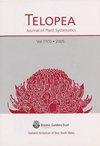澳大利亚新南威尔士州新英格兰高地Sphagnum-associated Desmids的分类和生态学
IF 0.5
4区 生物学
Q4 PLANT SCIENCES
引用次数: 0
摘要
研究了新英格兰高原生物区水陆栖和陆生生境中与Sphagnum L.有亲缘关系的小鼠类。本文介绍了80个分类群的描述和数据,其中9个是澳大利亚新记录的,另外7个是新南威尔士州新记录的。本文报道了两种新种双冠小锥虫(Micrasterias bicoronata A.Kenins)和藻质小锥虫(Cosmarium phymatodeum A.Kenins)。采用一种更适合于澳大利亚地脉菊的改良方案,对篮子沼泽地脉菊和Ebor Common地脉菊的区系组成进行了比较,以评估其保护价值。篮子沼泽获得了相对较高的分数,基于更大的物种丰富度和大量的地方性植物。相比之下,Ebor Common由于多样性较少和区域特有物种较少而得分较低。该研究还强调了澳大利亚Sphagnum中发现的desmid群落具有高度多样性(β比值比= 0.82),并且由于空间转换(β比值比= 0.15),在四个评估地点之间可能存在显著差异。虽然在中欧和西欧有一些物种与广泛研究的泥鳅栖息地相似,但澳大利亚有自己独特的泥鳅花元素。本文章由计算机程序翻译,如有差异,请以英文原文为准。
Taxonomy and ecology of Sphagnum-associated Desmids from the New England Tablelands, New South Wales, Australia
Desmids associated with Sphagnum L. from terrestrial and aquatic habitats were investigated in the New England Tableland Bioregion. Descriptions and figures for 80 taxa are presented herein, nine of which are newly recorded for Australia, and a further seven are newly recorded for New South Wales. Two novel species of desmid, Micrasterias bicoronata A.Kenins and Cosmarium phymatodeum A.Kenins, are described. The floristic composition of desmids at Basket Swamp and Ebor Common, were compared to assess their conservation value based on an existing and modified scheme better suited to desmids from Australia. Basket Swamp received a relatively high score based on greater species richness and numerous endemics present. In contrast, Ebor Common scored lower due to less diversity and few regionally endemic species. This study also highlights that the desmid community found amongst Sphagnum in Australia is highly diverse (βSOR = 0.82) and can differ markedly among the four assessed sites due to spatial turnover (βRATIO = 0.15). While there are species in common with the much more extensively studied Sphagnum habitats in central and western Europe, Australia has its own distinctive desmid floral elements.
求助全文
通过发布文献求助,成功后即可免费获取论文全文。
去求助
来源期刊

Telopea
PLANT SCIENCES-
CiteScore
1.30
自引率
42.90%
发文量
0
期刊介绍:
Manuscripts submitted for publication in TELOPEA are published online, after peer review and acceptance by the TELOPEA Editorial Committee and when final editorial formatting has been completed. The journal specialises in plant systematics and phylogeny. The geographic scope of the journal encompasses Australia, Malesia, Melanesia, Micronesia, and Polynesia. The suitability of a work for the journal depends on the topic and the region of origin, generally the narrower the focus of the manuscript the closer to New South Wales must be its geographic focus.
As a general guide, we will consider:
1) revisionary treatments and other substantial bodies of work from any of the regions mentioned above.
2) new species from any Australian state.
3) new country records for Australia from any state.
4) new state records from New South Wales only.
However, we aim to support botanical research across the broader Australasian and Pacific region, and will consider submissions on their merit.
Generally we will not consider extraterritorial new country records, or single lectotypification papers unless they pertain to New South Wales taxa, or have significant bearing on the Australian flora.
 求助内容:
求助内容: 应助结果提醒方式:
应助结果提醒方式:


